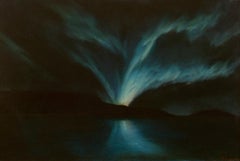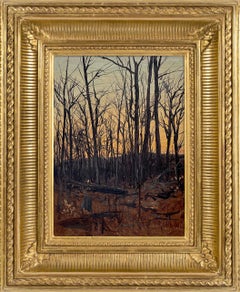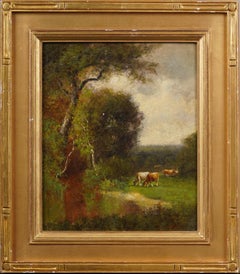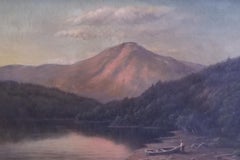William Bradford Art
to
2
Overall Width
to
Overall Height
to
2
2
2
2
1
1
1
1
1
1
2
2
1
1
1
2
8,232
2,807
1,650
1,318
1
2
Artist: William Bradford
Lights of the Aurora
By William Bradford
Located in New York, NY
Signed lower right: W Bradford
Category
Late 19th Century Hudson River School William Bradford Art
Materials
Oil, Board
Fishing Camp on the Labrador Coast
By William Bradford
Located in New York, NY
In 1852, twenty-nine year old William Bradford was a failing shopkeeper in Fairhaven, Massachusetts. With a wife and child at home, Bradford, by his own admission, “spent too much time in painting to succeed” in business. Rescued from insolvency by his well-to-do in-laws, this is not the beginning of a narrative that generally leads to a happy ending. Not so with Bradford, who ultimately found international fame and fortune as a painter of arctic seascapes and dramatic marine paintings.
William Bradford, the artist, was a lineal descendant of the 17th-century Separatist leader William Bradford, a founder of the Plymouth Plantation, signer of the Mayflower Compact and Governor of the Plymouth Colony. Our Bradford born to a New Bedford ship outfitter in Fairhaven, Massachusetts By the nineteenth century, this line of Bradfords were Quakers, living on the tract purchased nearly two centuries earlier by their pilgrim ancestor. Fairhaven, across the mouth of the Acushnet River from the whaling center of New Bedford was described by a New York journalist in 1857 as “the Brooklyn of New Bedford” (Home Journal, January 3, 1857). Young Bradford displayed an early predilection for the arts, but his Quaker parents were disinclined to support this particular pursuit. After working in his father’s business and then for a dry goods merchant in New Bedford, by 1849 Bradford had set up in New Bedford as a “merchant tailor” offering outfits for “those going to California,” “seamen’s clothing,” custom-tailored “piece goods...
Category
19th Century American Realist William Bradford Art
Materials
Canvas, Paper, Oil
Related Items
Dusk Forest Scene, Catskills by Lockwood DeForest (American, 1850-1932)
Located in New York, NY
"Dusk Forest Scene, Catskills," 1875 by Hudson River School painter Lockwood DeForest (American, 1850-1932) is oil on artists card-stock and measures 9.5 x 7 inches. The work is signed by DeForest, and dated May 13, 1875 at lower right. The work is framed in an elegant, period appropriate frame, and ready to hang.
Lockwood de Forest was born in New York in 1850 to a prominent family. He grew up in Greenwich Village and on Long Island at the family summer estate in Cold Spring Harbor. As was customary for a cultivated family in the Gilded Age, the de Forests made frequent trips abroad. Excursions to the great museums, which were prominent on the de Forests agenda, deepened the young Lockwood's familiarity with European painting and sculpture. Though he had begun drawing and painting somewhat earlier, it was during a visit to Rome in 1868 that nineteen-year-old de Forest first began to study art seriously, taking painting lessons from the Italian landscapist Hermann David Salomon Corrodi (1844–1905). More importantly, on the same trip, Lockwood met one of America’s most celebrated painters, (and his maternal great-
uncle by marriage) Frederic Edwin Church (1826–1900), who quickly became his mentor. DeForest accompanied Church on sketching trips around Italy and continued this practice when they both returned to America in 1869. Early on in his career, de Forest made a habit of recording the date and often the place of his oil sketches, as to create a visual diary of his travels. Lockwood’s profession as a landscape painter can be primarily attributed to Frederic E. Church and his belief in the young artist’s talent.
De Forest often visited Church in the Hudson River community of Catskill where, in addition to sketching trips and afternoons of painting, he assisted with the architectural drawings and planning of Olana. In 1872, de Forest took a studio at the Tenth Street Studio Building in New York. During these formative years de Forest counted among his friend’s artists such as Sanford Robinson Gifford (1823–80), George Henry Yewell (1830–1923), John Frederick Kensett (1816–72), Jervis McEntee (1828–91), and Walter Launt Palmer (1854–1932).
Over the next decade de Forest experienced success as a painter. He exhibited for the first time at the National Academy of Design in 1872, and made two more painting trips abroad, in 1875–76 and 1877–78, traveling to the major continental capitals but also the Middle East and North Africa. His trip to the Middle East and the library at Church’s home, Olana, established his interest in design during his mid-twenties. From about 1878 to 1902, landscape painting was overshadowed by his activities and preoccupation with East Indian architecture and décor, a style that became quite fashionable in late nineteenth century America. From 1879-1883, de Forest founded Associated Artists along with Louis Comfort Tiffany, Candace Wheeler...
Category
19th Century Hudson River School William Bradford Art
Materials
Oil, Board
Antique American Hudson River School Cows Grazing Signed Framed Oil Painting
By William Hart
Located in Buffalo, NY
Incredible early American Hudson River School landscape painting by William Hart (1823 - 1894). Oil on board. Framed. Signed. Measuring 15 by 17 inches overall and image size, 1...
Category
1870s Hudson River School William Bradford Art
Materials
Oil, Board
$1,820 Sale Price
20% Off
H 15 in W 17 in D 2 in
Antique American 1900 SUNSET LUMINOUS Stream Landscape Figure W/ Boat
Located in New York, NY
Here we have an incredible Luminous Landscape with a boat in a stream by Charles P Appel (1857-1928)
Painting is very calm and soothing to look at….
amazing condition, unlined and ...
Category
1890s Hudson River School William Bradford Art
Materials
Oil
$4,600
H 26 in W 30 in D 3 in
Reflections of Trees at Dusk
Located in San Francisco, CA
Much about this late 19th-century painting remains a mystery, including the name of the artist who only left their identity in a single-letter monogram. But the work's moody embrace ...
Category
Late 19th Century Hudson River School William Bradford Art
Materials
Canvas, Oil
1880s Original Hudson River School Landscape -- Sunset Through The Forest
By Charles Russell Loomis
Located in Soquel, CA
Beautiful Hudson River School Original gouache autumnal landscape of vivid sunset through forest by Charles Russell Loomis (American 1857 - 1936), circa 1880. Warm and cool tones wit...
Category
1880s Hudson River School William Bradford Art
Materials
Paper, Gouache, Cardboard
$1,160 Sale Price
20% Off
H 13 in W 9.75 in D 0.2 in
Tree Study
By Frederic Edwin Church
Located in Fredericksburg, VA
This exquisite tree study, attributed to the renowned American landscape painter Frederic Edwin Church, captures the artist's profound connection...
Category
Late 19th Century Hudson River School William Bradford Art
Materials
Oil, Board
Norway III, dark blues and blacks, night sky
By Gregory Frux
Located in Brooklyn, NY
Dr. Rowland S. Russell PhD. writes about his experience directly witnessing Greg's practice as a “plein air” artist:
Whether he’s portraying quiet scenes from Brooklyn’s Prospect Park or the Botanical Gardens, intriguing remnants of New York’s varied industry (grain silos...
Category
2010s American Realist William Bradford Art
Materials
Canvas, Oil
Hudson River School Style - The Homestead and Grist Mill 1942
By A. Mathieu
Located in Soquel, CA
Hudson River School Style - The Homestead and Grist Mill 1942
In the Hudson River School style by A (K) Mathieu (American, 19th-20th C). Harvest time at the Homestead with a hay wago...
Category
1940s Hudson River School William Bradford Art
Materials
Oil, Illustration Board, Stretcher Bars
$1,480 Sale Price
20% Off
H 21.5 in W 25 in D 2.25 in
'Boats at Dock', by C. Hjalmar Amundsen, Oil on Canvas Painting
Located in Oklahoma City, OK
C Hjalmar Amundsen's 'Boats at Dock' is a Mid-20th Century Oil on Canvas painting depicting a sailing vessel docked next to a couple of wharf buildings. The colors are rich values of...
Category
Mid-20th Century American Realist William Bradford Art
Materials
Canvas, Oil
$1,280 Sale Price
20% Off
H 19.875 in W 23.875 in D 1.75 in
Oil Summer Landscape
Located in Fredericksburg, VA
James Renwick Brevoort (1832–1918) was an influential American landscape painter associated with the Hudson River School, a mid-19th century art movement known for its romantic portr...
Category
Mid-19th Century Hudson River School William Bradford Art
Materials
Oil, Board
Antique Early American Southern Hudson River School Boys Swimming Oil Painting
Located in Buffalo, NY
Rare early American sunset Hudson River School swimming hole painting. Framed. Oil on board. Image size, 7.25H by 10L.
Category
1860s Hudson River School William Bradford Art
Materials
Oil, Board
$3,000 Sale Price
20% Off
H 9 in W 12.5 in D 1 in
Oil Miniature Sailboat Landscape
Located in Fredericksburg, VA
Frederick J. Sykes (1851-1905) was a remarkable artist of the Hudson River School, renowned for capturing the serene beauty of tranquil landscapes. His work often featured New Englan...
Category
Late 19th Century Hudson River School William Bradford Art
Materials
Oil, Board
Previously Available Items
Whiteface Mt, Lake Placid NY
By William Bradford
Located in Saratoga Springs, NY
Signed lower left
A 19th-century marine painter, William Bradford is famous for his seascapes that reflect his background of being raised in an area known for whaling and other marine activities. During much of his career, his work focused on the Arctic region, which he depicted with strong color and spectacular lighting.
Bradford was born and raised in New Bedford, Massachusetts to Quaker parents who disapproved of his desire for a painting career. He became a clerk in his father's dry goods shop in New Bedford but devoted his spare time to sketching, a diversion that caused him and his wife to lose a farm that had been given to them by his father-in- law.
In the early 1850s, living in Fairhaven, he launched his professional career by selling portraits of ships for twenty-five dollars a piece. In 1854, he opened a studio and about this same time attracted the interest of Albert Van Beest, a Dutch painter who had come to America in 1845. He became Bradford's teacher and collaborator, and until his death in 1860, they painted together local scenes including seascapes and whaling pictures.
In 1861, Bradford began a series of trips to Nova Scotia, Labrador, and Greenland, and painting and photographing the Arctic region became a consuming interest. He also published a book in London titled The Arctic Region, which he vividly illustrated with photographs pasted onto the page and he gave lectures accompanied by lantern slides...
Category
Late 19th Century Hudson River School William Bradford Art
Materials
Canvas, Oil
William Bradford art for sale on 1stDibs.
Find a wide variety of authentic William Bradford art available for sale on 1stDibs. You can also browse by medium to find art by William Bradford in oil paint, paint, canvas and more. Not every interior allows for large William Bradford art, so small editions measuring 11 inches across are available. Customers who are interested in this artist might also find the work of William Trost Richards, William Rickarby Miller, and Jasper Francis Cropsey. William Bradford art prices can differ depending upon medium, time period and other attributes. On 1stDibs, the price for these items starts at $25,000 and tops out at $375,000, while the average work can sell for $50,000.



